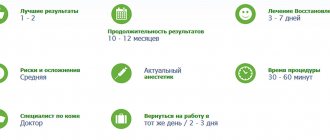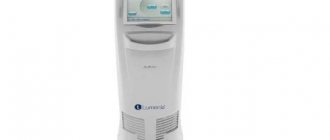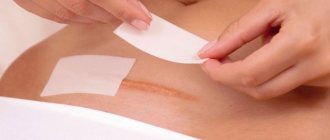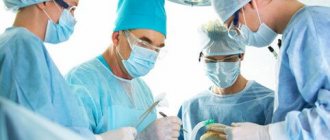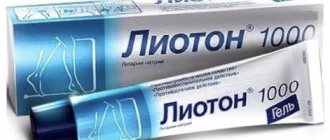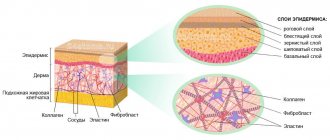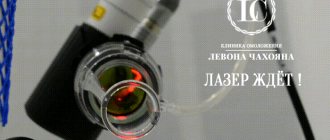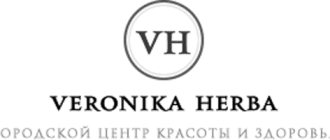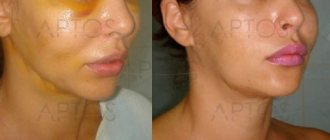From this article you will learn:
- What types of scars are there?
- What is laser scar resurfacing used for?
- What effect does laser resurfacing help achieve?
- Who is contraindicated for laser resurfacing?
- How to prepare for the procedure
- How does the procedure work?
- How long does the recovery process take after laser resurfacing?
Many people are concerned about the problem of scars left from acne, injury or surgery. Most girls know that it is almost impossible to remove this cosmetic defect on your own. Only a professional can offer an effective solution to the problem. For example, today laser scar resurfacing is considered one of the most advanced and effective techniques. The laser quickly eliminates scars, eliminating their reappearance, and does not cause any complications or skin problems. There are practically no contraindications to the procedure, so it is accessible to everyone.
What you need to know about scars
The appearance of scars causes pain on the skin, making it difficult to move the facial muscles. Soreness and unaesthetic appearance cause anxiety and stress.
Even small scars on the face cause a lot of negative emotions. Specialists of modern cosmetology and medicine are concerned with finding effective methods for the prevention, correction and treatment of this problem.
A mechanical wound heals within a year. This is a complex recovery process that ends with the appearance of a scar. Changes in tissues continue after healing, but they all occur slowly and imperceptibly to the eye.
Before you decide whether you will correct your scars with laser resurfacing or some other method, you need to determine the nature of the defect. There are physiological and pathological scarring. In the first case, scars form after injuries. They are pale, almost invisible. Pathological scars are usually large and bright in color.
Treatment should be selected based on the individual characteristics of the damage: the size of the scar, the duration of its existence on the skin, and the nosological form. It is impossible to completely remove scars that have already formed. Correction can significantly reduce damage and smooth the skin. Usually this process is very long.
An advanced modern technique for correcting such defects is laser scar resurfacing.
Let's try to figure out what scars are and why they occur.
By their nature, these are dense formations in the connective tissue of the skin. This defect appears during the healing process of the injuries received. In areas of scar formation, the tissue contains collagen, which is why the scars acquire a special shade. In these areas, the sweat glands and hair follicles will no longer be able to recover. Scars do not change color from exposure to ultraviolet radiation.
Read material on the topic: Atrophic scars on the face - causes of formation and main methods of treatment
Number of sessions
After fractional laser rejuvenation of the eyelids and other problem areas, rehabilitation of 3–7 days is required. The duration of the rehabilitation period will depend on the patient's lifestyle. For example, bad habits, poor nutrition, excessive physical activity, stress and disturbed sleep can significantly slow down skin regeneration after the procedure.
During the first three days after the session, redness and slight swelling may appear on the skin. To reduce the level of discomfort, you can take painkillers and use skin cooling products.
It is considered normal if during the first week the skin feels tight and peels in some places. Side effects include a bronze tint to the face, which disappears after 14 days.
A lasting result can be achieved by performing two to five procedures. A cosmetologist can tell you exactly how many sessions are needed, depending on each individual case and the client’s initial data.
The interval between sessions should be at least 3-4 weeks. Fractional laser rejuvenation slows down aging: wrinkles decrease or disappear completely, turgor increases, pores narrow, and complexion evens out. This method effectively removes pigmentation, post-acne, stretch marks and scars.
Types and stages of scars
Types of scar damage:
- Atrophic. Formed as a result of minor skin lesions (after acne). They are slightly retracted into the skin and have a light whitish tint.
- Normotrophic. Appear as a result of minor injuries and damage to the skin. Such scars do not have a bright shade, they are almost invisible to the eye.
- Hypertrophic. This type is typical for more serious skin injuries. The scar areas are compacted and rise above the surface of the skin. This problem can affect the arms and neck area.
- Keloids. At the site of these scars, connective tissue grows around the scar. These are dense, lumpy formations that are distinguished by a bright shade (pink or bluish). This type of skin defect manifests itself not only externally. It causes itching and pain. Laser resurfacing of a keloid scar will be more complex.
Knowing the type of scars on your skin will help you choose the appropriate treatment method.
Scars form in areas of former skin damage. This could be inflammation, injury, or cuts. During the healing process, connective tissue rich in collagen is formed.
Because of this, scars:
- smoother than the rest of the skin;
- have fewer functional properties;
- do not change shade when tanning.
In this case, hair follicles and sweat glands are not restored. Scars vary in color and appearance.
Modern medicine does not answer the question of why keloid scars appear and why pain occurs. The formation of hypertrophic scars is explained by the skin's overly sensitive reaction to injury. Atrophic and normotrophic scars are formed as a result of a natural reaction to minor damage.
Read material on the topic: Laser removal of stretch marks in a beauty salon: pros and cons of the procedure
Possible side effects
Complications after fractional laser rejuvenation procedures are extremely rare. Most often, negative consequences are observed due to the unprofessional actions of a cosmetologist who neglects the processing instructions. Sometimes side effects occur due to the client's failure to follow skin care recommendations.
Most likely complications:
- severe hyperemia of the skin, which goes away on its own after three days;
- swelling;
- dark skin tone;
- excessive dryness and flaking of the skin;
- burns;
- scars and cicatrices;
- white or yellow milia raised above the surface (dense nodules that form under the skin);
- inflammatory processes in damaged areas;
- the phenomenon of hyperpigmentation (may appear as a result of exposure to sunlight).
Complications after fractional laser rejuvenation will not appear if you prepare well before the procedure, choose a reliable clinic and an experienced professional.
When is laser scar resurfacing necessary?
Scars can cause a lot of discomfort. Laser resurfacing is used for any type of damage. Indications for going to a cosmetologist are light or sunken, dense and raised scars on the skin.
Laser resurfacing is different in that it can eliminate defects even in the most delicate areas (for example, on the eyelids). Most similar techniques in cosmetology do not have this feature.
The laser also successfully deals with large, rough scars that have been on the skin for a long time.
Laser resurfacing of facial scars is considered the only method that significantly reduces or completely eliminates the defect. During the procedure, a professional removes the very top layer of skin where the scar is located. Thanks to the high temperature, the natural production of collagen and elastin begins, and as a result we get a healthy area of skin of a normal shade. The sooner you visit a cosmetologist, the more effective the recovery will be.
Modern clinics use only modern equipment. These are devices manufactured in America and Europe. Erbium and carbon dioxide lasers are commonly used. The first option works well for superficial damage, the second - if laser resurfacing of keloid scars is performed.
Recommended articles on the topic:
- Painless lip modeling: techniques and recommendations
- Beauty injections: types, preparations, reviews
- Eyelash restoration at home and in a beauty salon
The essence of the procedure
In the first stages, grinding reduces the depth of scar formations. In the future, the scar can be removed almost completely.
Laser resurfacing of facial scars occurs according to the following principle. First, the laser removes the stratum corneum that makes up the scar itself. In the freed area, cells begin to divide intensively, and natural production of collagen and elastin occurs. Thanks to these substances, a new layer of healthy, smooth skin is formed in the scar area. The device has a built-in cooling system, which prevents overheating of the epidermis from laser beams. We are also seeing a significant reduction in recovery time after the procedure.
After laser treatment, thin channels will remain in the skin tissue, where new cells will begin to form over time. Dead skin particles will evaporate through small holes that are formed in the upper skin due to the action of the device. The rest of the skin surface will not be affected by the laser. Its appearance and internal structure will remain the same.
On the face, laser resurfacing even removes scars from sensitive areas such as the eyelids and lips.
Professionals advise visiting a cosmetologist as soon as possible after the damage has healed. Those scars that have been on the skin for less than six months are removed quickly and almost completely. Usually one or two procedures are enough for this. Deep damage requires longer correction.
Using the laser resurfacing method, you will get the following effect:
- smoothing the skin surface;
- changing the color of the scar to a normal healthy shade;
- gradual and complete removal of the scar.
In the photo: a device used for laser resurfacing of scars.
The optimal period for visiting a cosmetologist for a course of procedures is autumn or winter (cold season). It is important that during the recovery stage the skin is protected from sunlight. Immediately after the session, she is irritated by the laser, and ultraviolet light can provoke the formation of dark spots near the scars (due to increased melatonin production).
Laser facial resurfacing should only occur after prior consultation with a cosmetologist. A professional will take into account not only the size and time that the scar is on the skin, but also the characteristics of your body.
Read material on the topic: Removal of warts with laser: technology, consequences, recommendations
Contraindications for such rejuvenation
Fractional rejuvenation, like any cosmetic procedure, is not suitable for everyone. Therefore, in order to avoid negative consequences, before the session it is necessary to carefully study all contraindications.
Fractional photothermolysis is not recommended:
- during pregnancy and during breastfeeding, since any changes that occur in the body of a pregnant or lactating woman affect the baby - you should not risk the child’s health, it is better to postpone the procedure;
- in case of inflammation (or redness) in the treated area, the cosmetologist will refuse to carry out fractional laser photothermolysis in the cheek area if they are covered with an allergic rash (the laser beam can damage the skin up to deep scars);
- for chemical peeling - if you have cleansed your face, you need to allow the layers of the epidermis to strengthen for two weeks (minimum) and prepare for exposure to the laser beam;
- in the presence of oncological diseases, since spontaneous complications may arise as a result of laser exposure;
- with diagnosed diabetes mellitus;
- in the presence of viral and bacterial infections - in order to avoid the invasion of foreign elements into the cell structure during fractional rejuvenation, it is first necessary to recover completely.
Laser scar resurfacing: indications and contraindications
The laser works successfully on scars of varying complexity.
You can sand after:
- acne (post-acne);
- burns, including chemical ones;
- injuries;
- animal bites;
- surgical operations (including after caesarean section and plastic surgery).
Laser resurfacing can be done anywhere on the skin where scars have formed: on the forehead, on the back, on the chest. The procedure is performed in professional clinics by cosmetologists. Many people wonder how much a laser for scar resurfacing costs. It will not be possible to perform this procedure at home, since the required device is a massive and expensive device, and special skills are required to set it up.
Contraindications to laser resurfacing:
- vitiligo;
- keloid scars;
- diabetes;
- psoriasis;
- oncopathology;
- chronic diseases;
- scleroderma;
- epilepsy;
- hemophilia and other coagulation disorders;
- infectious diseases, including herpes.
Reviews about the procedure will tell you whether or not to do laser scar resurfacing. Please note that it should not be performed during exacerbations of chronic diseases, menstruation, pregnancy and breastfeeding.
Read material on the topic: Laser removal of papillomas - painless disposal of tumors
Benefits of fractional laser rejuvenation
This technology has been used in the field of cosmetology for more than 10 years. It is effective, safe and has a number of advantages when compared with other rejuvenating and healing techniques:
- practically does not cause side effects;
- non-invasive, so there is no chance of client infection (including HIV);
- painless and quite comfortable;
- allowed from 16 years of age;
- hygienic, since the instruments do not come into contact with the skin;
- suitable for atonic skin types;
- it is possible to choose an individual treatment program;
- Suitable for clients with any degree of skin pigmentation;
- areas with defects are treated pointwise, so the possibility of damage to healthy tissue around is excluded;
- due to the fact that only 25% of the skin is injured, the recovery period after the procedure is short (face – seven days, body – 14 days);
- the effect becomes noticeable immediately after the first procedure;
- the result obtained lasts for several years;
- it is possible to treat delicate areas;
- in affected areas, elastin production is significantly accelerated.
Preparation for laser scar resurfacing
Preparation before the procedure is carried out to ensure that dark spots do not form on the skin after laser exposure.
14–20 days before the session you need to exclude:
- solarium;
- taking medications that increase skin sensitivity to ultraviolet radiation: ointments such as Protopic, Psoralen, drugs Doxycycline, Griseofulvin, Etacridine, Phenothiazine;
- tanning in the sun;
- taking anti-acne medications with vitamin A (“Roaccutane”, “Acnecutane”).
During the described period and during recovery after laser resurfacing of scars, it is necessary to treat the scar areas with a protective agent before each exposure to the sun.
Brad Pitt
In recent photographs, there are no large “bags” under the star’s eyes, which accompanied the actor’s latest images and roles until the premiere of the film “Once Upon a Time in Hollywood.” This rejuvenation is the result of laser resurfacing under the eyes, complemented by Botox injections around the corners of the eyes to smooth out crow's feet.
Brad Pitt. The result of laser resurfacing of the skin around the eyes
The main stages of the laser scar resurfacing procedure
Stages of laser scar resurfacing:
- Treatment of the affected area with a medical antiseptic.
- Using anesthetics on the scar area.
- Wearing safety glasses.
- Grinding. At the same time, the client feels a slight tingling sensation. Modern cosmetology clinics use advanced fractional lasers Bison More-Xel and DANA medical S-CO2. The price for polishing scars with these devices is quite high, but the effect will pleasantly surprise you.
- Treating the scar area with a soothing gel.
- Applying an aseptic dressing to the scar site.
Read material on the topic: Laser facial skin rejuvenation: useful tips and recommendations
The essence of fractional laser rejuvenation
One of the newest modern developments in the field of cosmetology is the technique of fractional laser rejuvenation. Currently, it is not without reason that it can be called the most popular of all laser therapy procedures.
During the session, a laser beam passed through a special fractional grid breaks up into a large number of microbeams. This method provides a targeted (fractional) effect on the skin without completely disrupting it.
Recommended articles on the topic:
- Ultrasonic facial peeling is a pleasant and beneficial procedure for your skin
- Redermalization of the skin: all the pros and cons
- Almond peeling for the face: features of the procedure
Many tiny treatment areas are formed in the dermis layer, where the development of renewed young skin tissue occurs very quickly. Cells located around the affected areas begin intensive division, filling the damaged areas. As a result, rejuvenating processes in the deep layers of the dermis are stimulated. Micro-rays, affecting the middle and upper layers of skin tissue, help eliminate pigmentation, wrinkles and scars.
Fractional laser rejuvenation of facial skin helps it gain firmness and elasticity. In addition, thanks to the procedure, pores are significantly reduced, the oval of the face becomes more toned, the shade and texture of the skin becomes smoother, and wrinkles and scars are significantly smoothed out.
Rehabilitation period after scar resurfacing
The photo above shows the skin before and after laser scar resurfacing.
The recovery period after the session lasts 5–7 days.
At this time, it is important to follow the rules recommended by cosmetologists:
- For three days, do not lubricate the scar area with creams and ointments. You can only use restorative compounds prescribed by a specialist.
- Do not scrub or peel the damaged area for three weeks.
- Do not comb the treated area or remove scabs.
- For a month after laser resurfacing of acne scars and other damage, it is necessary to treat the scar area with a protective cream before each exposure to the sun.
It is important to know how the skin will behave after the procedure. The first three days there is redness and swelling, after which there is peeling. However, these are not negative effects or a specialist mistake, but a natural reaction that should pass.
If the doctor performed resurfacing according to all the rules and used high-quality equipment, then the most serious side effect may be the formation of dark spots near the scar. This often happens if the patient has been in the sun for a long time after the procedure, neglecting the advice of the cosmetologist.
Next, we will look at reviews of the laser method, as well as photographs of scars before and after resurfacing.
Read material on the topic: Laser biorevitalization of the face without complications and side effects
At what age is the procedure indicated?
- Fractional CO2 exposure-resurfacing is done when indicated and is performed on patients over 18 years of age.
- Fractional CO2 exposure-rejuvenation is recommended for patients over 30 years of age.
The presence of indications and the absence of contraindications are the main criteria for choosing a technique.
The patient's main complaint: laxity above the navel and excess skin.
Where to sign up for laser scar resurfacing
Nowadays, you no longer have to spend a lot of time performing complex and unpleasant procedures at home. It is much easier to seek help from real professionals - the Veronika Herba beauty and health center, equipped with effective and modern equipment.
Why clients choose Veronika Herba Beauty and Health Center:
- This is a beauty center where you can take care of yourself at a reasonable cost, while your face and/or body will be treated not by an ordinary cosmetologist, but by one of the best dermatologists in Moscow. This is a completely different, higher level of service!
- You can receive qualified help at any time convenient for you. The beauty center is open from 9:00 to 21:00, seven days a week. The main thing is to agree with your doctor in advance on the date and time of your appointment.
Sign up for a consultation with a specialist by phone +7 (495) 085-15-13
, and you will see for yourself!
Price for services
| LASER COMPLEX MULTILINE, ERB | |||
| № | Name | Duration | price, rub. |
| 1 | Full face | 60-90 min | 15000 |
| 2 | Forehead | 30 min | 5000 |
| 3 | Cheeks | 30 min | 5000 |
| 4 | Chin | 30 min | 5000 |
| 5 | Upper lip | 30 min | 5000 |
| 6 | Laser blepharoplasty (upper and lower eyelids) | 30 min | 8000 |
| 7 | Neck | 30 min | 5000 |
| 8 | Face + neck | 60 min | 17000 |
| 9 | Cleavage | 30 min | 7000 |
| 10 | Face + neck + décolleté | 60 min | 20000 |
| 11 | Hands | 30 min | 5000 |
| 12 | 1 sq. cm | 10 min | 500 |
